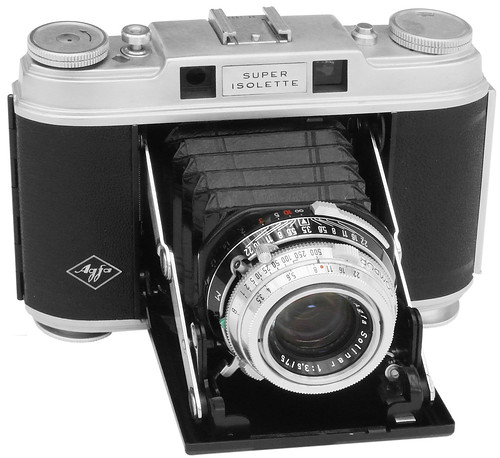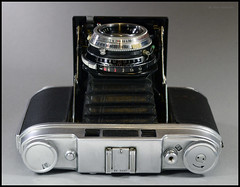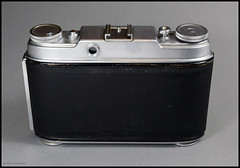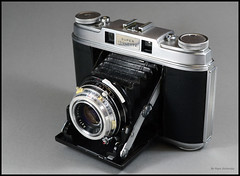Difference between revisions of "Super Isolette"
m (Minor design enhancement) |
Hanskerensky (talk | contribs) (Added link to review) |
||
| (16 intermediate revisions by 6 users not shown) | |||
| Line 1: | Line 1: | ||
| − | + | <div class="floatright plainlinks" style="margin:0px 0px 15px 15px";> | |
| − | |||
| − | |||
| − | |||
{{Flickr image | {{Flickr image | ||
| image_source=http://www.flickr.com/photos/alf_sigaro/2414600560/in/pool-camerawiki | | image_source=http://www.flickr.com/photos/alf_sigaro/2414600560/in/pool-camerawiki | ||
| image=http://farm3.staticflickr.com/2299/2414600560_3398c24d4b.jpg | | image=http://farm3.staticflickr.com/2299/2414600560_3398c24d4b.jpg | ||
| − | | image_align= | + | | image_align= |
| image_text= | | image_text= | ||
|image_by=Alf Sigaro | |image_by=Alf Sigaro | ||
| − | |image_rights= | + | |image_rights= non-commercial |
}} | }} | ||
| + | </div> | ||
| + | The '''Super Isolette''' is a coupled-rangefinder camera for 6×6 cm pictures on [[120 film]], made by [[Agfa]] from 1954-60.<ref name=McK>{{McKeown12}} p25.</ref>. "Super" refers to the addition of a [[rangefinder (device)|coupled rangefinder]], changes in the film transport and focusing system. The camera is an extension of the [[Isolette]] range of square-format folders; the Isolette III has an ''un-coupled'' RF; other Isolettes are all viewfinder cameras. However, the Super Isolette is very different from the other cameras, even though it was introduced only a little later than the Isolette I, II and III. | ||
| − | + | Besides a better fit and finish than all the other Isolettes: Focusing is performed by moving the whole front lens assembly instead of the front element, which is coupled via push-rod with the rangefinder. Film loading is semiautomated, and there is no red window in the back of the camera; the film is loaded in the camera and it advances until the 1st frame, then advances 1 frame at a a time. The double-exposure prevention interlock, has an indicator window by the shutter release. The film advance knob is on the right of the top housing. There is a film-type reminder on the left, in a knurled disc matching the film-advance. | |
| − | The | + | The Super Isolette was only sold with a 75 mm f/3.5 [[Solinar]] (4 elements/3 groups), the highest-grade lens offered among Agfa's folders, that accepts 32 mm slip-on filters or 29.5 mm screw-in ones. The shutter is either a Synchro-Compur MX for the early cameras or a Synchro-Compur MXV, fitted on cameras after serial numbers somewhere in the 7xxx range. Both these shutters offer a B,1-500 speed range and are synchronised for flash. |
| − | + | The Super Isolette was sold in the USA as the [[Ansco Super Speedex|Super Speedex]]. It was copied by KMZ as the [[Iskra]]. | |
| + | <br/><br/> | ||
| + | {| class="plainlinks" align="left" style="text-align: center;" | ||
| + | || [http://www.flickr.com/photos/29504544@N08/21417888855/in/pool-camerawiki/ http://farm1.staticflickr.com/735/21417888855_de6c26b7e7_m.jpg] [http://www.flickr.com/photos/29504544@N08/21407168422/in/pool-camerawiki/ http://farm6.staticflickr.com/5675/21407168422_27423f7f06_m.jpg] [http://www.flickr.com/photos/29504544@N08/21229659250/in/pool-camerawiki/ http://farm1.staticflickr.com/660/21229659250_b00bc57a49_m.jpg] | ||
| + | |- | ||
| + | || Agfa Super Isolette<br>Images by {{image author|Hans Kerensky}}. {{with permission}} | ||
| + | |} | ||
| + | {{br}} | ||
==Notes== | ==Notes== | ||
| + | {{Flickr_image | ||
| + | |image_source= | ||
| + | |image= | ||
| + | |image_align= | ||
| + | |image_text= | ||
| + | |image_by= | ||
| + | |image_rights= | ||
| + | }} | ||
| + | |||
<references /> | <references /> | ||
==Links== | ==Links== | ||
| − | |||
In English: | In English: | ||
| − | * [http://www.ph.utexas.edu/~yue/misc/AnscAgfa.html | + | * [https://web.archive.org/web/20110828032428/http://www.ph.utexas.edu/~yue/misc/AnscAgfa.html Super Isolette] profiled among other Agfa/Ansco folders, by [https://web.archive.org/web/20110902090127/http://www.ph.utexas.edu/~yue Andrew Yue] (archived) |
| − | * [ | + | *[https://certo6.com/camera-archive/agfa-super-isolette/ Notes on the Super Isolette] and PDF [https://certo6.com/wp-content/uploads/2018/05/SuperIsoletteInstructions.pdf User's manual for it] at [http://www.certo6.com Certo6.com]. |
* [http://www.jnoir.eu/en/cameras/agfa/super-isolette/ Agfa Super Isolette] on [http://www.jnoir.eu/en/ Pocketable History] by J. Noir | * [http://www.jnoir.eu/en/cameras/agfa/super-isolette/ Agfa Super Isolette] on [http://www.jnoir.eu/en/ Pocketable History] by J. Noir | ||
| + | *[https://www.kenrockwell.com/agfa/super-isolette.htm Super Isolette review] by [https://www.kenrockwell.com/index.htm Ken Rockwell] | ||
In Spanish: | In Spanish: | ||
| Line 33: | Line 48: | ||
[[Category: German 6x6 rangefinder folding]] | [[Category: German 6x6 rangefinder folding]] | ||
| + | [[Category:120 film]] | ||
[[Category: Agfa]] | [[Category: Agfa]] | ||
[[Category: Super]] | [[Category: Super]] | ||
Latest revision as of 03:40, 3 April 2024

|
| image by Alf Sigaro (Image rights) |
The Super Isolette is a coupled-rangefinder camera for 6×6 cm pictures on 120 film, made by Agfa from 1954-60.[1]. "Super" refers to the addition of a coupled rangefinder, changes in the film transport and focusing system. The camera is an extension of the Isolette range of square-format folders; the Isolette III has an un-coupled RF; other Isolettes are all viewfinder cameras. However, the Super Isolette is very different from the other cameras, even though it was introduced only a little later than the Isolette I, II and III.
Besides a better fit and finish than all the other Isolettes: Focusing is performed by moving the whole front lens assembly instead of the front element, which is coupled via push-rod with the rangefinder. Film loading is semiautomated, and there is no red window in the back of the camera; the film is loaded in the camera and it advances until the 1st frame, then advances 1 frame at a a time. The double-exposure prevention interlock, has an indicator window by the shutter release. The film advance knob is on the right of the top housing. There is a film-type reminder on the left, in a knurled disc matching the film-advance.
The Super Isolette was only sold with a 75 mm f/3.5 Solinar (4 elements/3 groups), the highest-grade lens offered among Agfa's folders, that accepts 32 mm slip-on filters or 29.5 mm screw-in ones. The shutter is either a Synchro-Compur MX for the early cameras or a Synchro-Compur MXV, fitted on cameras after serial numbers somewhere in the 7xxx range. Both these shutters offer a B,1-500 speed range and are synchronised for flash.
The Super Isolette was sold in the USA as the Super Speedex. It was copied by KMZ as the Iskra.
  
|
| Agfa Super Isolette Images by Hans Kerensky. (Image rights) |
Notes
- ↑ McKeown, James M. and Joan C. McKeown's Price Guide to Antique and Classic Cameras, 12th Edition, 2005-2006. USA, Centennial Photo Service, 2004. ISBN 0-931838-40-1 (hardcover). ISBN 0-931838-41-X (softcover). p25.
Links
In English:
- Super Isolette profiled among other Agfa/Ansco folders, by Andrew Yue (archived)
- Notes on the Super Isolette and PDF User's manual for it at Certo6.com.
- Agfa Super Isolette on Pocketable History by J. Noir
- Super Isolette review by Ken Rockwell
In Spanish:
- Agfa Super Isolette on Historia de Bolsillo by J. Noir